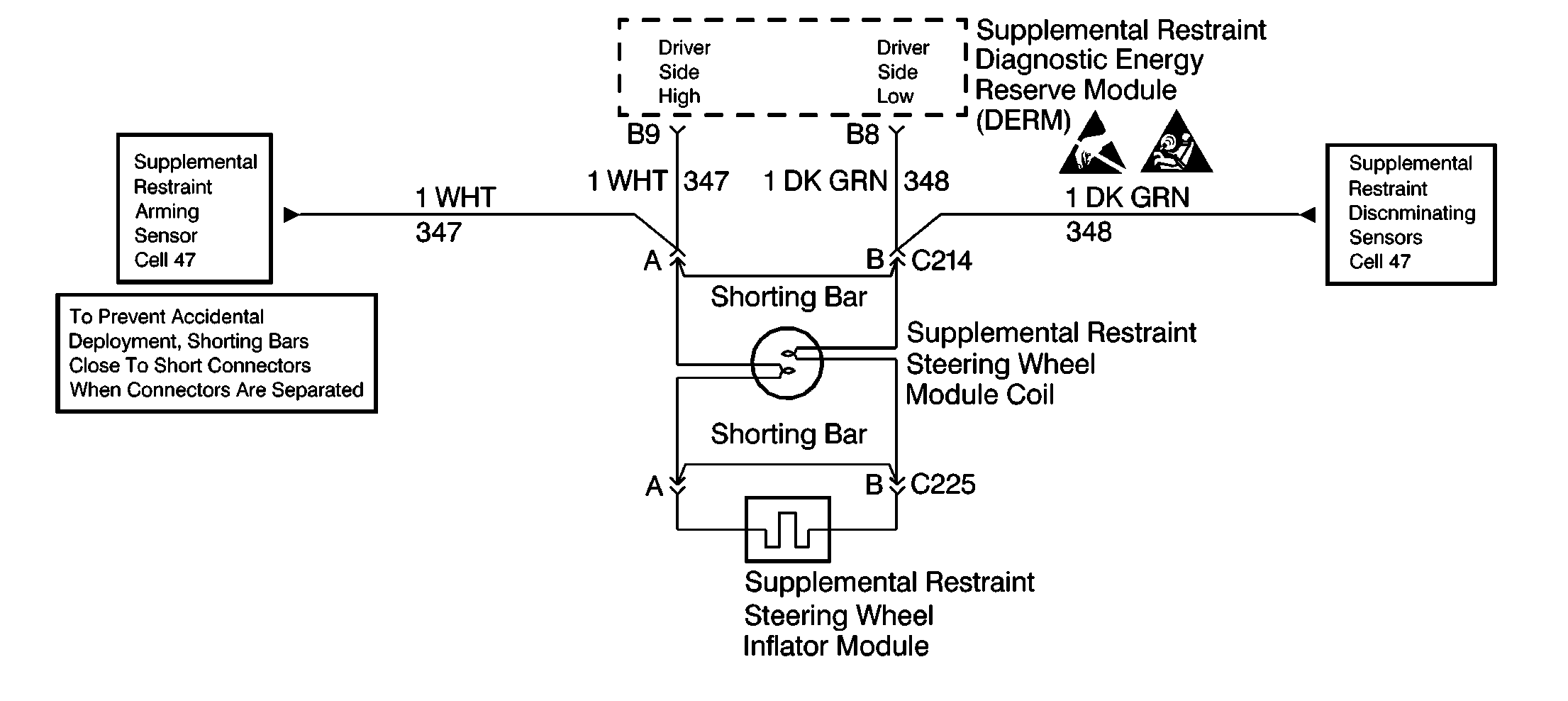
Circuit Description
During the Initiator Assembly Resistance test the supplemental restraint Diagnostic Energy Reserve Module (DERM) grounds the Driver Side Low terminal B8 and turns on the driver current source at the Driver Side High terminal B9. This causes a known amount of current to flow through the driver initiator circuit. By monitoring the difference between the voltage at the Driver Side High terminal B9 and the Driver Side Low terminal B8 the DERM calculates the combined resistance of the driver supplemental restraint steering wheel inflator module, Supplemental Restraint System (SRS) coil assembly, harness wiring circuits 347 and 348 and the connector terminal contact.
Conditions for Setting the DTC
The DTC sets when the combined resistance of the driver supplemental restraint steering wheel inflator module, supplemental restraint steering wheel module coil, harness wiring circuits 347 and 348, and the connector terminal contact measure above a specified value. This test runs once each ignition cycle during the Initiator Assembly Resistance Test when:
| • | No higher priority faults are detected during Turn On test. |
| • | No higher priority faults are detected during the Continuous Monitoring tests for one second. |
| • | No Crank signal is present. |
| • | Ignition 1 voltage measures above a specified value. |
Action Taken When the DTC Sets
The DERM turns on the AIR BAG warning lamp and sets a diagnostic trouble code.
Conditions for Clearing the DTC
The ignition switch is turned OFF.
Diagnostic Aids
The following poor connections may cause an intermittent condition:
| • | At the yellow 2-way connector at the base of the steering column. |
| • | At the DERM terminals B8 or B9. |
| • | At the top of steering column to the driver supplemental restraint steering wheel inflator module. |
This diagnostic trouble code test runs only while the AIR BAG warning lamp is performing the bulb check. When a scan tool issues a Clear Codes command and the malfunction still exists, the DTC will not reappear until the next ignition cycle.
Test Description
Refer to step numbers on the diagnostic table.
-
Start at the SRS Diagnostic System Check for all diagnosis.
-
This test checks for terminal deformation or contamination.
-
This test determines whether the malfunction is in the driver supplemental restraint steering wheel inflator module circuitry or in the DERM wiring harness circuitry.
-
This test determines whether the malfunction is in the driver supplemental restraint steering wheel inflator module or in the supplemental restraint steering wheel module coil
-
This test checks for high resistance in the Driver Side Low circuit.
-
This test checks for high resistance in the Driver Side High circuit.
When measurements are requested in this table, use J 39200 Digital Multimeter with correct terminal adapter from J 35616 Connector Test Adapter Kit. When a check for proper connection is requested, refer to Intermittents and Poor Connections in Section 8A4. When a wire, connector or terminal repair is requested, use J-38125 Terminal Repair Kit and refer to Wiring Repair.
Step | Action | Value | Yes | No |
|---|---|---|---|---|
Was the SRS Diagnostic System Check performed? | -- | |||
2 |
Are the terminals damaged or corroded? | -- | ||
3 | Replace the yellow 2-way electrical connector at the base of the steering column. Has the connector been replaced? | -- | -- | |
4 | Check for proper connection at terminals A and B on the supplemental restraint steering wheel module coil side of the 2-way connector. Are the terminals damaged or corroded? | -- | ||
5 | Check for proper connection at terminals A and B on the supplemental restraint steering wheel module coil side of the 2-way connector. Are the terminals damaged or corroded? | -- | ||
6 | Replace the supplemental restraint steering wheel module coil. Refer to Steering Column Unit Repair in Section 3F4. Has the supplemental restraint steering wheel module coil been replaced? | -- | -- | |
Is DTC B1021 current? | -- | |||
Is DTC B1021 current? | -- | |||
Is DTC B1021 current? | -- | |||
10 |
Has the supplemental restraint steering wheel inflator module been replaced? | -- | -- | |
11 |
Is the DERM electrical harness connector damaged or corroded? | -- | ||
12 | Repair the DERM electrical harness connector. Has the connector been repaired? | -- | -- | |
13 | Check for proper connection to the DERM at terminals B8 and B9. Are the DERM terminals damaged or corroded? | -- | ||
14 | Check for proper connection to the DERM at terminals B8 and B9. Are the DERM terminals damaged or corroded? | -- | ||
15 |
Has the DERM been replaced? | -- | -- | |
Measure the resistance between the DERM electrical harness connector terminal B8 and the yellow 2-way electrical connector terminal B. Is the resistance less than the value specified? | 1 ohms | Go to Step 17 | ||
17 | Repair the high resistance in circuit 348. Has the high resistance been repaired? | -- | -- | |
Measure the resistance from the DERM electrical harness connector terminal B9 to the yellow 2-way electrical connector terminal A. Is the resistance less than the value specified? | 1 ohms | Go to Integrity Check | ||
19 | Repair the high resistance in circuit 347 between the DERM electrical harness connector terminal B9 to the yellow 2-way electrical connector terminal A. Has the high resistance been repaired? | -- | -- | |
20 |
Have all the SRS components been reconnected and properly mounted? | -- | -- | |
21 | Clear the SRS Diagnostic Trouble Codes. Have the SRS Diagnostic Trouble Codes been cleared? | -- | -- |
